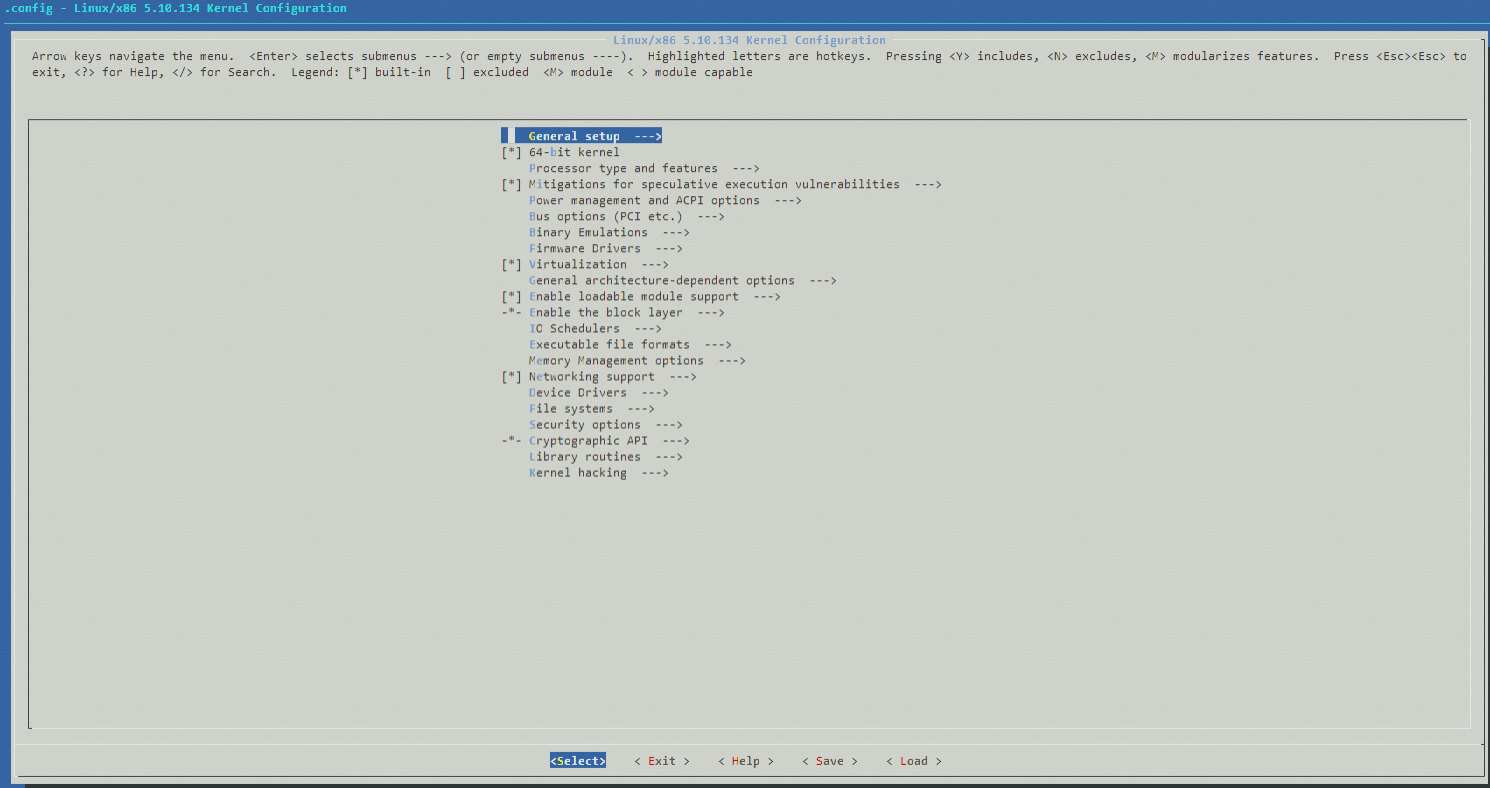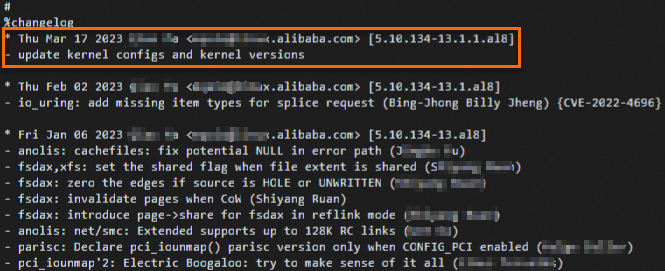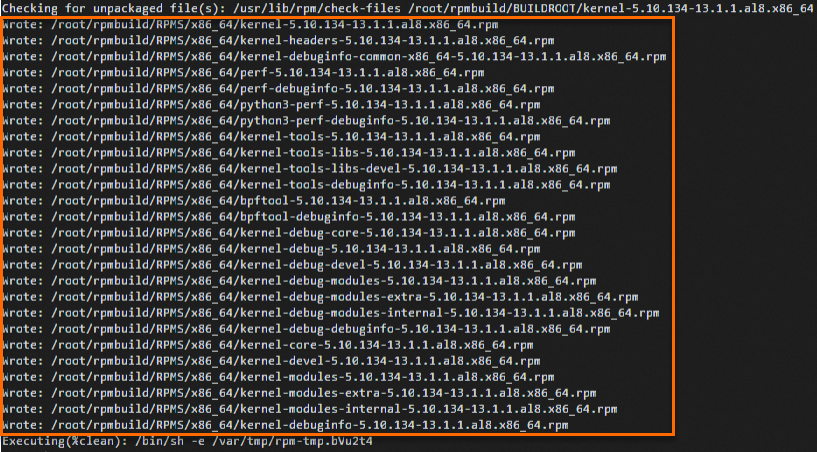In specific scenarios, you may need to enable specific features or modules in the Alibaba Cloud Linux kernel or disable specific features in the default kernel to meet specific performance or security requirements. To do these, modify the Alibaba Cloud Linux kernel source code and use the Red Hat Package Manager (RPM) to recompile and re-create custom kernel RPM packages. This ensures that the kernel in use is compatible with Alibaba Cloud Linux releases and able to flexibly meet specific business requirements. This topic describes how to modify and compile RPM packages of the Alibaba Cloud Linux kernel in a container based on the Alibaba Cloud Linux Elastic Compute Service (ECS) environment.
Prerequisites
An ECS instance that runs Alibaba Cloud Linux is created. For more information, see Create an instance on the Custom Launch tab.
The instance uses an Alibaba Cloud Linux 2 or 3 image.
The instance type that the instance uses has 32 or more vCPUs.
NoteIt takes a long period of time to compile an RPM package. We recommend that you use an instance type that has 32 or more vCPUs to improve compilation efficiency.
Step 1: Prepare the environment
Connect to the instance for which you want to modify and compile RPM packages of the Alibaba Cloud Linux kernel.
For more information, see Connect to a Linux instance by using a password or key.
Run the following commands to download an Alibaba Cloud Linux Docker image and access the Docker container:
#Install Docker. sudo yum install -y docker #Pull a Docker image. sudo docker pull <image_url> #Start the Docker container. sudo docker run -itd --net host --name alinux-build <image_url> bash #Access the Docker container. sudo docker exec -it alinux-build bashIn the preceding commands, replace
<image_url>with the URL of the Docker image that corresponds to Alibaba Cloud Linux 2 or 3. The following table describes the Docker image URLs.Image
Docker image URL
Alibaba Cloud Linux 2
alibaba-cloud-linux-2-registry.cn-hangzhou.cr.aliyuncs.com/alinux2/alinux2
Alibaba Cloud Linux 3
alibaba-cloud-linux-3-registry.cn-hangzhou.cr.aliyuncs.com/alinux3/alinux3
In this example, the Docker image that corresponds to Alibaba Cloud Linux 3 is downloaded. Sample commands:
sudo yum install -y docker sudo docker pull alibaba-cloud-linux-3-registry.cn-hangzhou.cr.aliyuncs.com/alinux3/alinux3 sudo docker run -itd --net host --name alinux-build alibaba-cloud-linux-3-registry.cn-hangzhou.cr.aliyuncs.com/alinux3/alinux3 bash sudo docker exec -it alinux-build bash
Step 2: Download the source code
Run the following commands to download the RPM package that you want to modify:
# Download the source code package.
yum install -y wget
wget <rpm_url>/<src.rpm_name>
# Install the source code package.
rpm -ivh <src.rpm_name>In the preceding commands, replace <rpm_url> with the URL of the RPM package that corresponds to Alibaba Cloud Linux 2 or 3 and <src.rpm_name> with the name of the RPM package that contains the source code (src.rpm package). The following table describes the download URL of the RPM package that corresponds to Alibaba Cloud Linux 2 or 3.
Image | RPM package URL |
Alibaba Cloud Linux 2 | |
Alibaba Cloud Linux 3 | https://mirrors.aliyun.com/alinux/3/plus/source/SRPMS/kernels/ |
In this example, the kernel-5.10.134-13.1.al8.src.rpm package that corresponds to Alibaba Cloud Linux 3 is downloaded. Sample commands:
yum install -y wget
wget https://mirrors.aliyun.com/alinux/3/plus/source/SRPMS/kernel-5.10.134-13.1.al8.src.rpm
rpm -ivh kernel-5.10.134-13.1.al8.src.rpmAfter you install the src.rpm package, the files of the src.rpm package are stored in the /root/rpmbuild directory. You can run the ls /root/rpmbuild command to query the files. Sample command output:

Step 3: Modify the source code
Run the following commands to install dependencies:
yum install -y rpm-build yum-utils yum-builddep -y <src.rpm_name>In the preceding command, replace
<src.rpm_name>with the name of the src.rpm package that you want to modify. In this example, <src.rpm_name> is replaced withkernel-5.10.134-13.1.al8.src.rpm. Sample commands:yum install -y rpm-build yum-utils yum-builddep -y kernel-5.10.134-13.1.al8.src.rpmRun the following commands to decompress the source code package:
# Enter the source code directory. cd /root/rpmbuild/SOURCES # Decompress the source code package. tar xf <Name of the compressed source code package>In the preceding command, replace
<Name of the compressed source code package>based on your needs. In this example, <Name of the compressed source code package> is replaced withlinux-5.10.134-13.1.al8.tar.xz. Sample command:cd /root/rpmbuild/SOURCES tar xf linux-5.10.134-13.1.al8.tar.xzRun the following command to enter the directory in which the decompressed source code package is located:
cd <Name of the decompressed source code package>In the preceding command, replace
<Name of the decompressed source code package>based on your needs. In this example, <Name of the decompressed source code package> is replaced withlinux-5.10.134-13.1.al8. Sample command:cd linux-5.10.134-13.1.al8Optional. Modify the source code or configuration files based on your needs. You can modify the source code based on your needs. This topic only describes how to modify configuration files. To modify configuration files, perform the following operations:
Run the following command to list all configuration files and select the configuration files that you want to modify:
ls /root/rpmbuild/SOURCES
The following table describes the configuration files in the
/root/rpmbuild/SOURCESdirectory.Configuration file
Description
kernel-5.10.134-aarch64.config
Arm architecture and release version of the config configuration.
kernel-5.10.134-aarch64-debug.config
The config configuration of the Arm architecture and debug version, which can be used only for testing.
kernel-5.10.134-x86_64.config
The configuration file of the x86 architecture and the release version.
kernel-5.10.134-x86_64-debug.config
The configuration file of the x86 architecture and the debug version, which is used only for testing.
In most cases, you can select
kernel-5.10.134-aarch64.configorkernel-5.10.134-x86_64.configfile based on whether the platform is an Arm or x86 architecture, or modify the configurations of both platforms at the same time.Run the following commands to modify a configuration file.
In this example, the
kernel-5.10.134-x86_64.configfile for the x86 architecture is used. Sample commands:Copy the configuration file to the source code directory.
cd /root/rpmbuild/SOURCES cp kernel-5.10.134-x86_64.config linux-5.10.134-13.1.al8/.configEnter the source code directory.
cd linux-5.10.134-13.1.al8Refresh the default value in the configuration file.
make olddefconfigUse menuconfig to modify the configuration file to ensure proper dependency configurations.
make menuconfigEnter the menuconfig window. You can press the
/key to search for the items that require modifications and modify the items based on your needs.
Copy the modified configuration file to overwrite the original configurations.
cp .config ../kernel-5.10.134-x86_64.configGo back to the parent directory.
cd ..
NoteYou can modify the config file for the Arm architecture in the same way.
Run the following commands to update the kernel version:
cd /root/rpmbuild/SPECS vi kernel.specSuggestions for modification:
If the kernel has a major version in the *-x format, such as
5.10.134-12, we recommend that you change the major version to a version in the *-x.y.z format, such as5.10.134-12.0.1. This way, you can distinguish the version from the official version.If the kernel has a minor version in the *-x.y format, such as
5.10.134-13.1, we recommend that you change the minor version to a version in the *-x.y.z format, such as5.10.134-13.1.1.
In the following example, the
5.10.134-13.1version number is updated to5.10.134-13.1.1. In the configuration file, find%define pkgrelease %{?KREL:%{KREL}}%{?!KREL:13.1}and change it to%define pkgrelease %{?KREL:%{KREL}}%{?!KREL:13.1.1}.
You can also add the change description in the
kernel.specchangelog.
Step 4: Re-create the RPM package
Run the following commands to recompress the src.rpm package.
In this example, the
linux-5.10.134-13.1.al8source code package is used.Enter the SOURCES directory.
cd /root/rpmbuild/SOURCES/Modify the file name of the source code directory.
In this example, version
5.10.134-13.1is changed to version5.10.134-13.1.1and the file name of the source code directory is modified tolinux-5.10.134-13.1.1.al8. Modify the file name based on your needs.mv linux-5.10.134-13.1.al8 linux-5.10.134-13.1.1.al8Recompress the source code package into a TAR package.
tar cJf linux-5.10.134-13.1.1.al8.tar.xz linux-5.10.134-13.1.1.al8Remove the decompressed directory and original compressed package.
rm -rf linux-5.10.134-13.1.al8 rm linux-5.10.134-13.1.al8.tar.xz
Run the following commands to re-create the src.rpm package:
cd /root rpmbuild -bs rpmbuild/SPECS/kernel.specThe following sample command output indicates that the src.rpm package is stored in
/root/rpmbuild/SRPMS/kernel-5.10.134-13.1.1.al8.src.rpm.
(Conditionally required) Run the following command to downgrade the dwarves package:
If your kernel version (queried by using the
uname -rcommand) is later than version5.10.014, you must use an early version of the Dwarves package for compilation. Otherwise, compilation errors may occur.yum downgrade dwarvesRun the following command to re-create the RPM package:
rpmbuild --rebuild /root/rpmbuild/SRPMS/<src.rpm_name>In the preceding command, replace
<src.rpm_name>with the modified name of the src.rpm package. In this example, the modified name of the src.rpm package iskernel-5.10.134-13.1.1.al8.src.rpm. Sample command:rpmbuild --rebuild /root/rpmbuild/SRPMS/kernel-5.10.134-13.1.1.al8.src.rpmIt takes a long period of time to compile an RPM package. The following sample command output indicates that the RPM package is re-created.
